The history of
Sierra Entertainment
Part 1 - The Early Years (1979-1983)
The birth of an
industry

 The
fantastic history of Sierra Entertainment started back in 1979 in the
home of Ken and Roberta Williams, an ordinary couple in their
mid-20:s, living in Simi Valley, Los Angeles with their two young sons
D.J.
and Chris.
The
fantastic history of Sierra Entertainment started back in 1979 in the
home of Ken and Roberta Williams, an ordinary couple in their
mid-20:s, living in Simi Valley, Los Angeles with their two young sons
D.J.
and Chris.
At the time,
Ken was working as a contract programmer for IBM, developing an income
tax program on a mainframe computer 3,000 miles away from L.A. One night
he found a program labeled "Adventure" on the mainframe. Curious
of what it could be, he downloaded it and it turned out to be a copy of
Colossal
Caves, the legendary text adventure game created by William Crowther
in 1972 and expanded by Don Woods in 1976. Back in the days of the
ARPAnet (the early Internet), this game was very famous. It was
the first true "interactive fiction" computer game. Ken (as so many
other people who saw the game) was very fascinated with it.
Roberta wasn't
very interested in computers at the time, but Ken showed her the game on
a terminal he had brought home from work. Roberta, who had been a big fairy-tale
and adventure fiction lover ever since her childhood, was instantly hooked
in this new breed of storytelling and played her way through Colossal
Cave with great enthusiasm.
 For
Christmas 1979, Ken bought a $2,000 Apple II microcomputer with
a whooping (for its day) 64k of memory, an 85k floppy disk drive and a
monochrome monitor. He was planning to use it to develop a FORTRAN compiler
for Apple computers. At the time, he could never have imagined in what
a dramatic way this purchase would affect his future, and indeed the future
of computer gaming itself!
For
Christmas 1979, Ken bought a $2,000 Apple II microcomputer with
a whooping (for its day) 64k of memory, an 85k floppy disk drive and a
monochrome monitor. He was planning to use it to develop a FORTRAN compiler
for Apple computers. At the time, he could never have imagined in what
a dramatic way this purchase would affect his future, and indeed the future
of computer gaming itself!
At the time,
a company called Adventure International developed text adventure
games for the Apple II. Roberta played their games, but even though she
liked them, she wasn't entirely content with the adventure games that existed
at the time. She realized that this medium had the possibilities to do
even more than presenting text descriptions on the screen. Modern computers
could display graphics! So, instead of telling the player ”You
are standing in front of a house”, why not just display a picture of
the house on the screen instead? The games could use better plots too,
making them even more interesting to play. A wild idea started to form
in her mind...
Roberta sat
down in front of the kitchen table and started to write down her ideas.
Three weeks later she presented to Ken the script of a computer game called
Mystery
House, an idea she had developed during the previous days, in between
watching the kids (D.J. was seven at the time and Chris was only one year
old) and doing other everyday household stuff. The game would revolve around
a murder mystery, where you as the player would be trapped overnight in
an old house together with seven other people, one of whom would be a killer.
But who? The house would also contain a hidden treasure that the player
had to find. (Inspiration was taken from the famous Agatha Christie story
Ten Little Indians and the parlor game Clue.) At first, Ken
wasn't very excited about her idea, but eventually Roberta caught his attention,
especially when she said she wanted the game to contain pictures instead
of just text.
Roberta managed
to talk Ken into helping her develop the game in the evenings after work.
Ken figured out a way to fit the amount of graphics she wanted into the
very limited memory of their Apple II computer and created the tools needed
to draw it, as there still were no drawing programs available on the market.
They bought a crude graphics drawing tablet with a mechanic arm that, with
lots of hard work, could transfer a drawing on a piece of paper to a computer
image. Ken also programmed the logic code needed in the game. Roberta worked
on the text and the graphics and told Ken how to put it all together to
make it the game she wanted. She did the quality assurance of the game
herself. They worked on it for about three months and in May 5 1980,
Mystery
House was finally ready for shipment! They placed a small ad in Micro
Magazine, made copies of the game themselves and packaged them in small
square folders, sealed inside ziplock bags. The boxart was designed by
Roberta's mother Nova, who was a good oil painter. The games were
then distributed to the only four (!) software stores available in Los
Angeles county at the time by Ken and Roberta personally. It cost $24.95
and was distributed under Ken's company name On-Line systems.

 With
their first computer game done, Ken and Roberta started to make plans for
the future. They thought that if they could just write games popular enough
to earn them about $40,000 a year, they could move out of Los Angeles in
a few years and live in a ”log cabin in the woods”, working together
at home, making computer games and raising their children in a peaceful
and beautiful environment close to nature instead of the big and busy city
of L.A. They had no idea that this humble dream would be a heavy understatement
to what was actually going to happen to them in the following years.
With
their first computer game done, Ken and Roberta started to make plans for
the future. They thought that if they could just write games popular enough
to earn them about $40,000 a year, they could move out of Los Angeles in
a few years and live in a ”log cabin in the woods”, working together
at home, making computer games and raising their children in a peaceful
and beautiful environment close to nature instead of the big and busy city
of L.A. They had no idea that this humble dream would be a heavy understatement
to what was actually going to happen to them in the following years.
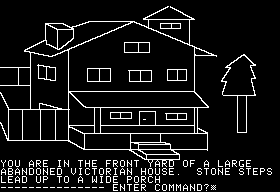
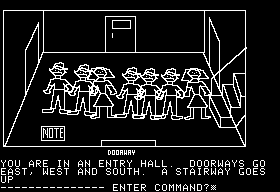
A change of lifestyle
Mystery House
was an instant hit. The graphics, although consisting only of crude line
drawings, monochrome and motionless, was something previously unseen in
an adventure game and people loved it! The orders were pouring in and so
was the money. By August 1980, Mystery House had already sold enough
copies to enable Ken and Roberta to move out of L.A. They bought a house
in Coarsegold, a small gold mining town in the Sierra Nevada foothills
just south of Yosemite National Park, where Roberta's parents John
and Nova owned an apple orchard.
Mystery
House is usually regarded as the first computer game ever to have graphics,
and as such is considered a classic game and a landmark achievement in
computer gaming history. It sold about 15,000 copies and earned $167,000,
an unprecedented number for the time. Ken and Roberta who had not anticipated
this huge popularity of the game would constantly get telephone calls day
and night by people who wanted to buy the game. They realized that suddenly,
30-40,000 people had become aware of their home phone number! After about
6 months they moved to the small mountain town of Oakhurst, seven
miles north of Coarsegold. Chaos lasted for about three more months in
their new home until Ken and Roberta finally hired an office, located on
top of a print shop, to take care of the business from. Their very first
employee was John Williams, Ken's brother, and the early On-Line
systems staff consisted mostly of friends and relatives of Ken and
Roberta. But the company was growing quickly...
Ken and Roberta's
second adventure game was Wizard and the Princess, a game with a
story based on the many fairy-tales Roberta used to read as a child. This
game was an improvement from Mystery House mainly because it had
color graphics. It's possible that it was the first computer game ever
to have color graphics (at least it was surely the first adventure game
with color) and it sold over 60,000 copies, truly an impressive number
for the early 80’s! The Apple II could only display six different colors
simultaneously, but clever use of pixel patterns, (a technique called dithering),
made it possible to give the illusion of more colors on the screen.
Wizard and
the Princess was also released for the Atari 8-bit, the Commodore
64 and, in 1982, for the IBM PC, then under the name Adventures
in Serenia.
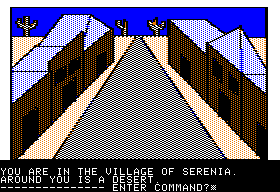
Mystery
House and Wizard and the Princess were the first two in a series
of about ten games, called the Hi-res Adventures, released between
1980 and 1982. Roberta and Ken were very involved in the design of most
of them.
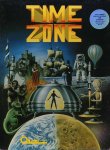 In
1981, Roberta broke the barriers of adventure gaming again with the release
of Time Zone, a game that was so big it spanned six double-sided
disks, far more than any previous computer game. It was the biggest computer
game ever made for about seven years. While the average adventure game
of the time usually had about 90 "rooms", Time Zone had about 1400!
This was also the first On-Line systems game with graphics drawn
by professional artists, and it took a full year to make. The game even
earned special recognition by the Smithsonian Institution. It was
first sold for $99.95, but that was much too expensive for most consumers
so the game didn't sell very well in the beginning and the price had to
be lowered.
In
1981, Roberta broke the barriers of adventure gaming again with the release
of Time Zone, a game that was so big it spanned six double-sided
disks, far more than any previous computer game. It was the biggest computer
game ever made for about seven years. While the average adventure game
of the time usually had about 90 "rooms", Time Zone had about 1400!
This was also the first On-Line systems game with graphics drawn
by professional artists, and it took a full year to make. The game even
earned special recognition by the Smithsonian Institution. It was
first sold for $99.95, but that was much too expensive for most consumers
so the game didn't sell very well in the beginning and the price had to
be lowered.
Sometime around
this period, On-Line systems changed their name to Sierra On-Line,
relating to their location in the Sierra Nevada area. They also adopted
the shape of Half Dome, one of Yosemite's most spectacular and famous
landmarks, in their logotype.


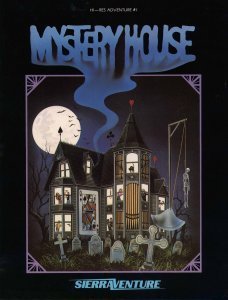 Roberta
also wrote The Dark Crystal in 1982, a game based on Muppets
creator Jim Henson's animated movie with the same name. It was released
under a new logo: SierraVenture. Some of the earlier games, including
Mystery
House and Wizard and the Princess were also re-released under
this new logo, packaged in more proffesional-looking boxes. The Dark
Crystal was later released in a simplified version intended for younger
players as The Gelfling Adventure. This game was the first one made
by Al Lowe, who a couple of years later would become one of Sierra
On-Line's most famous game designers. The Dark Crystal was the first
computer game to be based on a movie.
Roberta
also wrote The Dark Crystal in 1982, a game based on Muppets
creator Jim Henson's animated movie with the same name. It was released
under a new logo: SierraVenture. Some of the earlier games, including
Mystery
House and Wizard and the Princess were also re-released under
this new logo, packaged in more proffesional-looking boxes. The Dark
Crystal was later released in a simplified version intended for younger
players as The Gelfling Adventure. This game was the first one made
by Al Lowe, who a couple of years later would become one of Sierra
On-Line's most famous game designers. The Dark Crystal was the first
computer game to be based on a movie.
Alongside with
Sierra
On-Line, computer game company Infocom developed pure text adventure
games. Without the graphics they could utilize computer memory to develop
much better text parsers than Sierra On-Line, enabling the player to write
long and complicated sentences in the games. Sierra On-Line could not compete
with Infocom in this field, but they didn't really need to as they still
sold a lot of games.
Next to the
adventure games, Ken and Roberta's company also released a number of very
successful arcade games on license, such as Frogger and Jawbreaker.
These games were labeled SierraVision for some time. It's all a
bit confusing, but so was the computer industry as a whole during these
years. They even released a few non-entertainment software products, such
as the HomeWord Speller word processor. Ken was working hard during
this initial period of the company to gain understanding of the digital
entertainment industry so he could lead the company in the right direction.
His opinion of computer games had changed dramatically in these few years.
Hundreds of letters from all over the country, though many of them unfortunately
lost when the Williams' Coarsegold house burnt to the ground in 1982, told
Ken and Roberta that the games they were making were important to people.
Even Apple co-founder Steve Wozniak, obviously a real hero in Ken's
eyes, sent them a letter and told them what a delight it was to see their
games run on the Apple II. This was an important encouragement to Ken,
as he had to face an uncertain future for the company...
On
to Part 2 - The Golden Days (1984 - 1988)
Back
to The History of Sierra Entertainment - Main page
Back
to The King's Quest Chronicles - Main page
 For
Christmas 1979, Ken bought a $2,000 Apple II microcomputer with
a whooping (for its day) 64k of memory, an 85k floppy disk drive and a
monochrome monitor. He was planning to use it to develop a FORTRAN compiler
for Apple computers. At the time, he could never have imagined in what
a dramatic way this purchase would affect his future, and indeed the future
of computer gaming itself!
For
Christmas 1979, Ken bought a $2,000 Apple II microcomputer with
a whooping (for its day) 64k of memory, an 85k floppy disk drive and a
monochrome monitor. He was planning to use it to develop a FORTRAN compiler
for Apple computers. At the time, he could never have imagined in what
a dramatic way this purchase would affect his future, and indeed the future
of computer gaming itself!

 The
fantastic history of Sierra Entertainment started back in 1979 in the
home of Ken and Roberta Williams, an ordinary couple in their
mid-20:s, living in Simi Valley, Los Angeles with their two young sons
D.J.
and Chris.
The
fantastic history of Sierra Entertainment started back in 1979 in the
home of Ken and Roberta Williams, an ordinary couple in their
mid-20:s, living in Simi Valley, Los Angeles with their two young sons
D.J.
and Chris.

 With
their first computer game done, Ken and Roberta started to make plans for
the future. They thought that if they could just write games popular enough
to earn them about $40,000 a year, they could move out of Los Angeles in
a few years and live in a ”log cabin in the woods”, working together
at home, making computer games and raising their children in a peaceful
and beautiful environment close to nature instead of the big and busy city
of L.A. They had no idea that this humble dream would be a heavy understatement
to what was actually going to happen to them in the following years.
With
their first computer game done, Ken and Roberta started to make plans for
the future. They thought that if they could just write games popular enough
to earn them about $40,000 a year, they could move out of Los Angeles in
a few years and live in a ”log cabin in the woods”, working together
at home, making computer games and raising their children in a peaceful
and beautiful environment close to nature instead of the big and busy city
of L.A. They had no idea that this humble dream would be a heavy understatement
to what was actually going to happen to them in the following years.



 In
1981, Roberta broke the barriers of adventure gaming again with the release
of Time Zone, a game that was so big it spanned six double-sided
disks, far more than any previous computer game. It was the biggest computer
game ever made for about seven years. While the average adventure game
of the time usually had about 90 "rooms", Time Zone had about 1400!
This was also the first On-Line systems game with graphics drawn
by professional artists, and it took a full year to make. The game even
earned special recognition by the Smithsonian Institution. It was
first sold for $99.95, but that was much too expensive for most consumers
so the game didn't sell very well in the beginning and the price had to
be lowered.
In
1981, Roberta broke the barriers of adventure gaming again with the release
of Time Zone, a game that was so big it spanned six double-sided
disks, far more than any previous computer game. It was the biggest computer
game ever made for about seven years. While the average adventure game
of the time usually had about 90 "rooms", Time Zone had about 1400!
This was also the first On-Line systems game with graphics drawn
by professional artists, and it took a full year to make. The game even
earned special recognition by the Smithsonian Institution. It was
first sold for $99.95, but that was much too expensive for most consumers
so the game didn't sell very well in the beginning and the price had to
be lowered.


 Roberta
also wrote The Dark Crystal in 1982, a game based on Muppets
creator Jim Henson's animated movie with the same name. It was released
under a new logo: SierraVenture. Some of the earlier games, including
Mystery
House and Wizard and the Princess were also re-released under
this new logo, packaged in more proffesional-looking boxes. The Dark
Crystal was later released in a simplified version intended for younger
players as The Gelfling Adventure. This game was the first one made
by Al Lowe, who a couple of years later would become one of Sierra
On-Line's most famous game designers. The Dark Crystal was the first
computer game to be based on a movie.
Roberta
also wrote The Dark Crystal in 1982, a game based on Muppets
creator Jim Henson's animated movie with the same name. It was released
under a new logo: SierraVenture. Some of the earlier games, including
Mystery
House and Wizard and the Princess were also re-released under
this new logo, packaged in more proffesional-looking boxes. The Dark
Crystal was later released in a simplified version intended for younger
players as The Gelfling Adventure. This game was the first one made
by Al Lowe, who a couple of years later would become one of Sierra
On-Line's most famous game designers. The Dark Crystal was the first
computer game to be based on a movie.